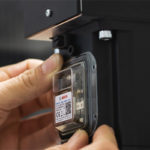Infineon is launching a next-generation analog MEMS microphone that renders even better results – the XENSIV MEMS microphone IM73A135. In microphones, designers often have to accept trade-offs: high signal-to-noise ratio (SNR), a small package, high acoustic overload point, low power consumption, MEMS versus electret condenser microphones (ECM). For this reason, applications that require the highest performance microphones may have previously still used ECMs instead of MEMS. The IM73A135 reduces the need to compromise.
A 73 dB SNR and a high acoustic overload point (135 dB SPL) make for a very high dynamic range microphone with a small footprint of 4 x 3 x 1.2 mm3. Infineon’s new MEMS microphone also features tight frequency curve matching for the most effective audio signal processing and the industry’s lowest power consumption of 170 microamperes. The IM73A135 thus allows designers to reach a level of high audio performance restricted to ECMs while at the same time reaping the benefits inherent in MEMS technology.
Infineon’s new MEMS microphone offers excellent characteristics to enhance active noise cancellation in headphones, a market that will grow to approximately 250 million devices by 2025 with a CAGR of 16 percent*2. Additionally, the low self-noise makes the IM73A135 especially suited for high-quality audio capturing required in conference systems, cameras, or audio recorders. A market that is also expected to increase significantly.
Infineon is not only expanding its portfolio of branded MEMS microphones but also extending its lead via a new low power digital ASIC technology. This lowest power technology will be used in various next-generation digital microphones manufactured and branded by the “Infineon-inside” microphone partner network. An industry-leading low power mode current consumption of as little as 110 microampere makes it a perfect match for the wearables segment, including smartwatches, fitness bands, etc. The growing demand for aesthetically appealing products with the ability to serve the consumers’ daily needs better will grow this market to reach approximately 650 million units by 2025, at a CAGR of almost 20 percent over a forecast period from 2020 to 2025*3.
The XENSIV MEMS microphone IM73A135 will be available for the distribution market in March 2021. The new MEMS microphone technology for wearables will be launched by the “Infineon-inside” partners in the next months.





